#Oligocene
Text
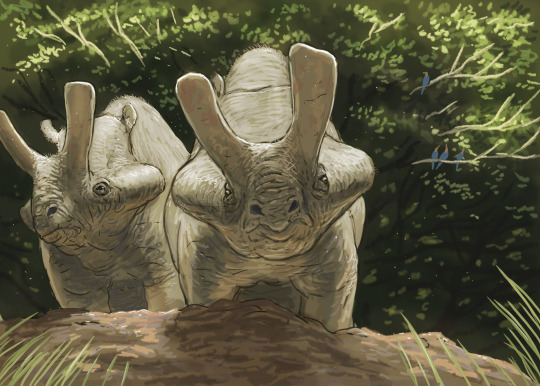
Another #paleostream sketch
Bronotheres and underrated creatures, look how goofy Megacerops for example is in frontal view.
1K notes
·
View notes
Text
A Brief History of Flamingos
People wanted it so here it is, a brief rundown of flamingos throughout prehistory, which is essentially a brief summary of extinct flamingo species that I worked on for Wikipedia.
Because of this, I'll stick to the two main famillies, the Palaeolodidae ("swimming flamingos") and Phoenicopteridae (true flamingos) and leave aside the misc. early forms we don't know are actually related or not.
Palaelodidae
Palaelodids, occasionally referred to as "swimming flamingos" are an interesting and surprisingly long lasting group, containing 3 genera, 10 species and ranging from the Oligocene to the Pleistocene across all continents bar Africa and Antarctica.
The oldest palaelodid is Adelalopus hoogbutseliensis from the Early Oligocene of Belgium. Not much to be said other than that its name is an anagram of Palaelodus.
Palaelodus is the most widespread of the genera in the family, with the type species being Palaelodus ambiguus from the Oligocene and Miocene of Europe. I did actually make a whole post about the genus before here. Anyways, P. ambiguus is the best known species thanks to the ample material collected at Saint-Gérand-le-Puy, France. Remains were also found in Germany and maybe Brazil?
Brazil is interesting, because already by the Oligocene palaelodids were nearly cosmopolitan. Two other species, Palaelodus pledgei and Palaelodus wilsoni, have been recovered from the Oligocene to Miocene of Australia, half a world away from P. ambiguus. P. pledgei is the smallest known species of Palaelodus.
During the early Miocene we also get Palaelodus aotearoa, from New Zealand, and from the middle Miocene Palaelodus kurochkini from Mongolia. The later of the two may in fact be its own genus, but for now its deemed Palaelodus.
Generally, Palaelodus is less specialised than flamingos, though living in brackish waters and feeding on small aquatic insects, they didn't yet have the same suffisticated filter feeding bill as todays flamingos. Whats debated is how they moved. Some suggest wading, others diving and again others propose the idea that they may have been swimmers.
There is one more note on this group, which is that there are some remains assigned to P. wilsoni that appear to have been Pleistocene in age? Obviously this would be a massive deal, but it has also been suggested that this could be a new species given the time gap or a whole new genus. Still, palaelodid remains from the Pleistocene are still incredible.
Palaelodus by Alphinyx and Tom Simpson


The last member of the Palaelodidae is Megapaloelodus. Yes they misspelled Palaelodus in the genus name. The definition of this form is kinda vague and mostly based on size, which is why there's so many issues around Megapaloelodus goliath. You see it was initially described based on its size, but when larger remains of Megapaloelodus were found it was transferred to that genus. However, all other Megapaloelodus species are from the Americas, so thats kinda odd, although of course not a dealbreaker. Still, future research might change things up here.
While Megapaloelodus goliath was contemporary and found at the same place as Palaelodus ambiguus, all others are found in Miocene to Pliocene deposits of America.
Megapaloelodus connectens is the type species and known from the Miocene of South Dakota and California.
Megapaloelodus peiranoi may be the basalmost species and was discovered in Miocene deposits of Argentina.
Finally, we got Megapaloelodus opsigonus from Oregon and possibly Baja California. As this is the youngest species, from the Pliocene, its name means "born in a later age".
Megapaloelodus by Joschua Knüppe (with Argentavis) and Scott Reid

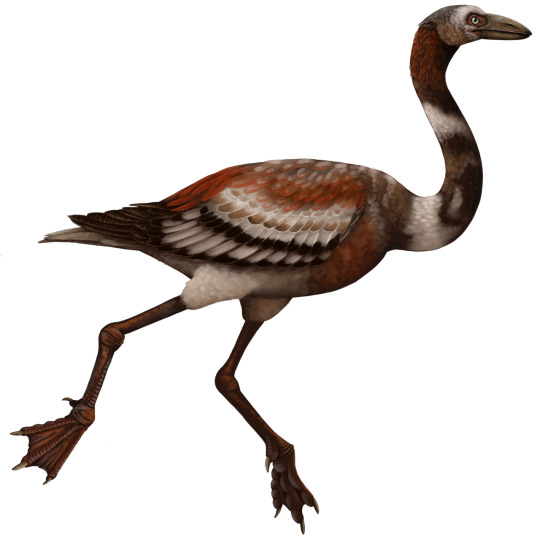
Which actually wraps up palaelodids. Yeah the majority of studies are focused on palaelodids, no surprise given its the only one with really good remains. But based on said animal, its a fascinating group.
This means we can move on to true flamingos, members of the family Phoenicopteridae. I hope you like that name btw, because goddamn "Phoenico" is an overused prefix for these animals to a ridiculous degree. Even I struggled keeping up.
Just to set the stage, lets establish the modern flamingos, split into two to three genera. There is the Lesser Flamingo (Phoeniconaias minor), the only extant member of its genus and native to Africa and Asia. There are two species of Phoenicoparrus, the Andean and Jame's flamingos (Phoenicoparrus andinus and Phoenicoparrus jamesi respectively), both endemic to South America. And then there's the three species of Phoenicopterus. The incredibly whidespread Greater Flamingo (Phoenicopterus roseus), the American Flamingo (Phoenicopterus ruber) and the Chilean Flamingo (Phoenicopterus chilensis). As if the Greater and American flamingos didn't already have latin names way too similar, they were also synonyms for a while so thats fun when they get brought up in old papers.
Chart of living flamingos by Mr. Gharial

Anyways, lets reset to the Oligocene and do this semi-chronologically as before. And yes, Oligocene. Because contrary to what you might think, palaelodids, as we currently think of them as, aren't the ancestors to flamingos and more a really weird sister group that appeared from the same common ancestor aroundt he same time.
Thankfully, we get to start with something fun and not confusing, Harrisonavis croizeti. Another one I did actually cover in detail on Tumblr right here. The short of it is that Harrisonavis already bears the hallmarks of modern flamingos, possessing that classic curved bill and certainly doing some filter feeding already. And if you paid attention you might recognize where its from. Saint-Gérand-le-Puy, France. Yup, this guy coexisted with Palaelodus and Megapaloelodus. Must have been a fascinating place.
Harrisonavis and Palaelodus by Joschua Knüppe

Of course this being a well known form, we gotta follow it up with something bad. Elornis is, simply put, a mess. We aren't even super sure if its a flamingo or not and its history is convoluted. All we can say for sure is that it lived during the late Oligocene in France.
Like palaelodids, true flamingos seem to have dispersed rapidly, as our next entry managed to reach Australia by the late Oligocene. Phoeniconotius eyerensis, I repeat that one, PhoenicoNOTIUS (you see what I mean with things getting confusing?) is a genus from the Lake Eyre Basin of South Australia. It was a comparably robust animal, much more massive than other flamingos and perhaps more of a wader than a swimmer, staying away from deeper waters?
Same time same place we got Phoenicopterus novaehollandiae. PhoenicoPTERUS, as in the same genus as American and Greater flamingos. Now this guy sticks mostly to the same stuff as its relatives, thus differing clearly from Phoeniconotius.
Phoeniconotius (foreground), Phoenicopterus novaehollandiae (?, middle) and palaeolids (background) by Frank Knight, Phoeniconotius by Anne Musser


We can now move into the Miocene. We get a brief break from Phoenico names courtesy of Leakeyornis aethiopicus from Kenya. Tho its not super well preserved, its among the few fossil flamingos with known skull remains, so thats gotta count for something.
Skeletal by me, art by Joschua Knüppe
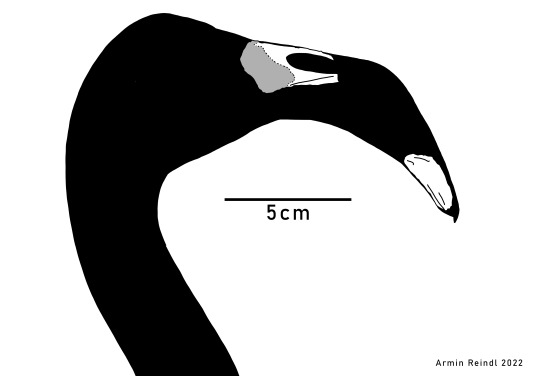
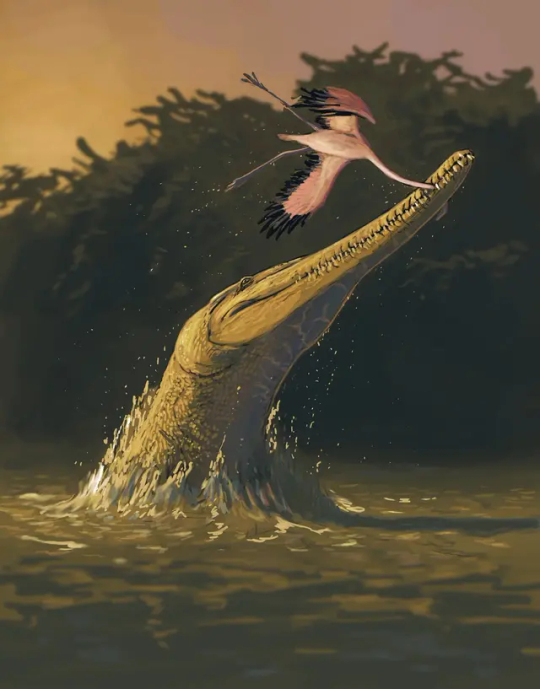
Also during the Miocene, we get the appearance of the genus Phoeniconaias (PhoenicoNAIAS) thanks to Phoeniconaias siamensis. A small species, only slightly larger than today's Lesser Flamingo, its remains are exclusively known from the Mae Long Reservoir in northern Thailand.
Fossil material of P. siamensis alongside a Lesser Flamingo via เบิร์ดโบราณ - Ancient bird on Facebook
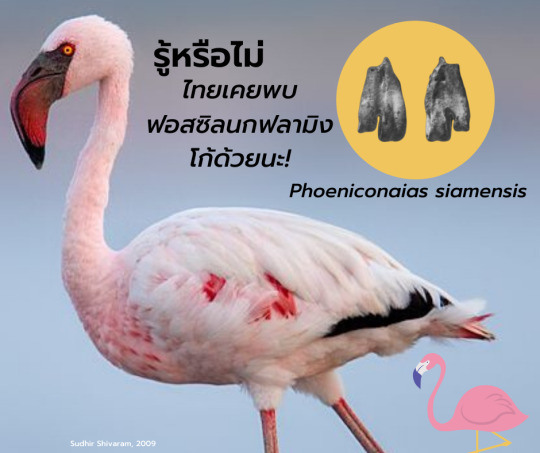
And already we find ourselves in the Pliocene. Oh how time flies. Lets wrap up known fossil species of Phoeniconaias then while we're at it. Phoeniconaias proeses is a species from Australia. Unlike our friend from Thailand, this one is actually smaller than its modern relative. It also coexisted with two other flamingos. Fossils from the region have been assigned to the Greater Flamingo and one other form we'll cover next.
Xenorhynchopsis. Our last truly original name. Xenorhynchopsis minor is the older of the two, Pliocene in age and the species I just alluded to earlier. The genus then went on to continue into the Pleistocene via Xenorhynchopsis tibialis. Neither is especially well known and both had been named by de Vis, who while no doubt an important contributor to Australian paleontology also had plenty of flaws I'll discuss soon with my next post on mekosuchines. Anyways, Xenorhynchopsis has a cool name, a confusing history (they were described as storks) and likely died out when the inland waterways of Australia dried up.
Its all downhill from here folks. It's all PhoenicoPTERUS from now on and none of them are especially good. Lets rewind to the Pliocene to cover them properly.
We got Phoenicopterus floridanus from the early Pliocene of, who guessed it, Florida. It may have also inhabited North Carolina.
Phoenicopterus stocki, or Stock's Flamingo, lived during the middle Pliocene in Mexico. Tho not well described, we got juvenile remains too, young individuals that were not yet capable of flight.
Finally we got two Pleistocene species.
Phoenicopterus minutus from California, specifically Lake Manix. Lake Manix also yielded fossils tentatively assigned to the other Pleistocene fossil species.
Phoenicopterus copei. While fossils of P. minutus are currently exclusive to Lake Manix, P. copei was more widespread, ranging from Mexico in the south to Oregon in the north as well as California in the west and Florida in the east. Where it coexisted with other flamingos, like P. minutus and American flamingos, it would have been the larger species.
And thats it. All the fossil flamingos of the Palaelodidae and Phoenicopteridae. Alas, bird fossils preserve notoriously poorly and though stuff like the ends of tibiatarsi and tarsometatarsi are diagnostic, they aren't super helpful to making them sound interesting to the average joe. So sorry if this whole post is a little dry in spots.
#palaelodidae#phoenicopteridae#palaelodus#megapaloelodus#adelolepus#leakeyornis#harrisonavis#elornis#phoenicopterus#phoenicoparrus#phoeniconaias#phoeniconotius#xenorhynchopsis#palaeoblr#paleontology#prehistory#oligocene#miocene#pliocene#pleistocene#cenozoic#flamingo#phoenicopteriformes#long post
158 notes
·
View notes
Text
youtube
Watch the 2024 American Climate Leadership Awards for High School Students now: https://youtu.be/5C-bb9PoRLc
The recording is now available on ecoAmerica's YouTube channel for viewers to be inspired by student climate leaders! Join Aishah-Nyeta Brown & Jerome Foster II and be inspired by student climate leaders as we recognize the High School Student finalists. Watch now to find out which student received the $25,000 grand prize and top recognition!
#ACLA24#ACLA24HighSchoolStudents#youtube#youtube video#climate leaders#climate solutions#climate action#climate and environment#climate#climate change#climate and health#climate blog#climate justice#climate news#weather and climate#environmental news#environment#environmental awareness#environment and health#environmental#environmental issues#environmental education#environmental justice#environmental protection#environmental health#high school students#high school#youth#youth of america#school
15K notes
·
View notes
Text
Astorgosuchus, the Giant from the Bugti Hills

Astorgosuchus bugtiensis ( formerly Crocodilus bugtiensis ) was a large basal Crocodyloid from the Oligocene of Bugti Hills in Pakistan. There are only 3 specimens described, which includes a fragmentary rostrum and 2 fragmentary dentaries. The specimen reconstructed here is NHMUK R.5266, a missive fragmentary dentary.
The reconstruction of the mandible is based on Asiatosuchus germanicus, a basal Crocodyloid. This results in a mandible length of 156 cm which makes it a contender for the largest Crocodyloids and the largest Crocodylians ever. They were apex predators of the region and preyed on a variety of animals including Paraceratherium, Rhinoceros and Chalicotheres.
References:
Martin et al., (2019). A large crocodyloid from the Oligocene of the Bugti Hills, Pakistan
#astorgosuchus bugtiensis#astorgosuchus#crocodile#croc#crocodilian#crocodilia#crocodylomorpha#pseudosuchia#fossil#paleontology#skeletal#oligocene#pakistan#size comparison#paleoart
74 notes
·
View notes
Text

During the Rupelian (older Oligocene age), the area I live in was a shallow sea (in some places you can find small fossil seashells and stuff), so I thought it would be cool to draw it
100 notes
·
View notes
Text
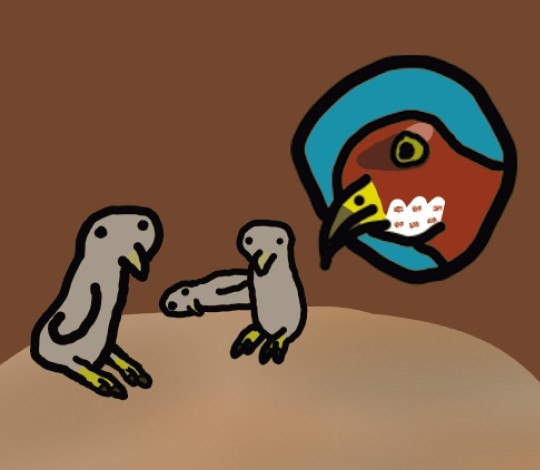
Fossil Novembirb: Day 14
A mother Aviraptor and her chicks
36 notes
·
View notes
Text
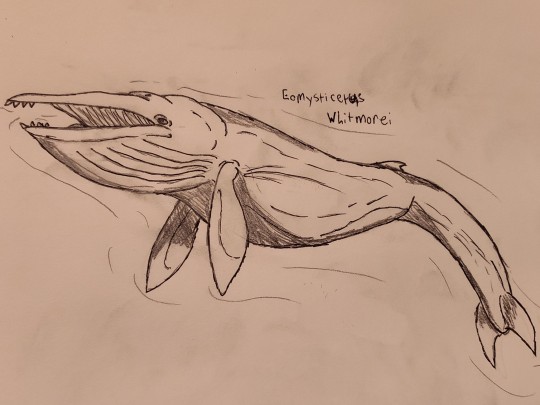
Eomysticetus (dawn baleen whale) was a mysticete that lived around 25 million years ago, and was discovered in South Carolina. Much like Aetiocetus, this whale had both teeth and baleen, although its baleen were much more prominent, and its teeth were likely vestigial. It most likely primarily utilized filter feeding like modern baleen whales, gulping loads of water and filtering microorganisms from the water. Bulk feeding in this way would prove to be a useful adaptation and would allow these creatures to get absolutely massive.
#eomysticetus#paleoart#paleontology#evolution#baleen whale#whales#whale evolution#whale#cetacean#cetaceans#oligocene#paleogene
19 notes
·
View notes
Text
youtube
Watch the American Climate Leadership Awards 2024 now: https://youtu.be/bWiW4Rp8vF0?feature=shared
The American Climate Leadership Awards 2024 broadcast recording is now available on ecoAmerica's YouTube channel for viewers to be inspired by active climate leaders. Watch to find out which finalist received the $50,000 grand prize! Hosted by Vanessa Hauc and featuring Bill McKibben and Katharine Hayhoe!
#ACLA24#ACLA24Leaders#youtube#youtube video#climate leaders#climate solutions#climate action#climate and environment#climate#climate change#climate and health#climate blog#climate justice#climate news#weather and climate#environmental news#environment#environmental awareness#environment and health#environmental#environmental issues#environmental justice#environment protection#environmental health#Youtube
15K notes
·
View notes
Text

Paraceratherium, one of the largest known land mammals. Growing around 15-17 feet at the shoulder, and weighing up to 15 to 20 tons, this extinct rhino relative was about the height of a giraffe, and was double the mass of an elephant.
#paraceratherium#paleoart#paleontology#oligocene#paleogene#mammal#cenozoic#extinctmammal#extinctspecies#rhino#digitalart#krita
30 notes
·
View notes
Text
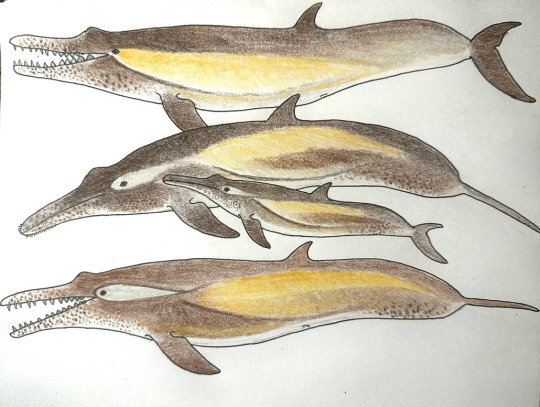
Impressions of the species of the basal baleen whale Coronodon from the Oligocene of South Carolina, from bottom to top: C.havensteini, C.planifions at center and C.newtonorum at the top. The latter two were just described a couple of months ago.
References:
32 notes
·
View notes
Text

Day 18: Squalodon calvertensis
A extinct genus of whales of the Oligocene and Miocene epochs, belonging to the family Squalodontidae.
#my art#paleoart#myart#my drawings#mammals#cetacean#squalodon#oligocene#miocene#cenozoic#toned tan#sketchbook
10 notes
·
View notes
Text
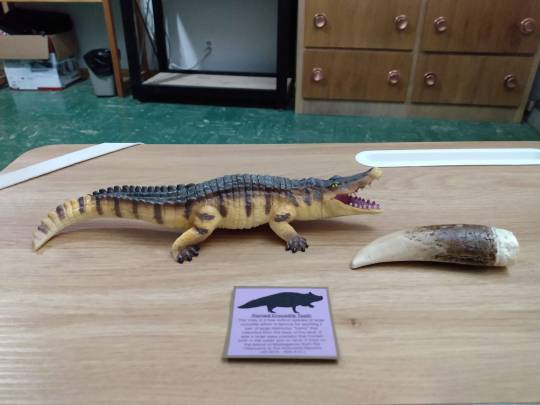



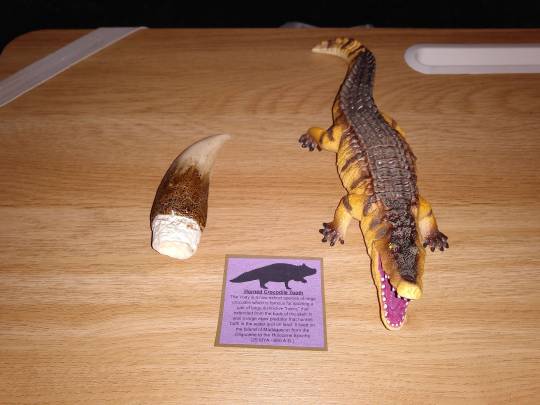

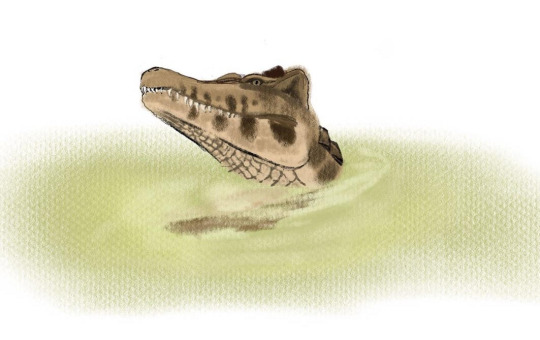

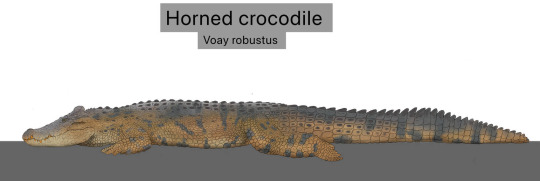

Todays fossil is a replica Voay tooth. Also known as the horned crocodile, the voay is an extinct genus of crocodilian which lived throughout swamps, rivers, wetlands, and coast regions of Madagascar until as recently as 50 A.D. It is on this massive island that the voay lineage became isolated and split off from crocodiles back in the Oligocene some 25 million years ago. Reaching upwards of 16ft (5m) in length and 500lbs (226kg) in weight the voay is the largest predator known to have roamed Madagascar since the extinction of the non avian dinosaurs and would have feed upon Fish, Birds, Amphibians, Fruit, Mammals, Invertebrates, and Other Reptiles. It sported a sorter and broader skull than most modern crocodiles with a distinctive pair of boney head crest. It also had much more robust, strongly built legs indicating that the voay likely spent almost as much time on land as it did the water. Admittedly inaccurate Toy made by creatology.
Art Belongs to the following creators:
Sobek1926: https://www.deviantart.com/sobek1926/art/Voay-robustus-the-horned-crocodile-of-Madagascar-936382947
Unenlagia90: https://www.deviantart.com/unenlagia90/art/Voay-robustus-918530868
Nixdraws: https://nixillustration.com/science-illustration/2019/voay/
#pleistocene#pleistocene pride#pliestocene pride#pliestocene#extinct#madagascar#crocodile#crocodilian#oligocene#voay#horned#horned crocodile#africa#paleontology#paleoart#cenozoic
27 notes
·
View notes
Text
Spectember D25: Ontogenetic niche shifts

Earth has recovered from a mass extinction just about 30 million years ago which would correspond to the time of the Oligocene, this version of earth happened the mass extinction of the K/Pg was delayed, so instead of ending in 66 million years ago cretaceous continued for other 30 million years until the asteroid struck down, ending the Mesozoic and so starting a new period of history of life, the delay of this mass extinction changed some aspects of evolutionary development of many groups, mammals did not became the only dominant clade in this time, many reptiles survivors have also took over, and with the short span of time that has passed to our modern times, the fauna amalgamation is a sort of reminiscence of the Eocene and even the Triassic, but cooler as the planet faced the glacial ages up to the Pleistocene.
In the ocean marine mammals are a thing of course, but they aren’t alone, Choristodere and crocodiles are also common if not predominant in the coasts and freshwater regions by a large amount, choristoderes in fact are coming in a path convergent to sauropterygians now resembling those to a big degree, with varied short body and long necked forms, predatory forms similarly to nothosaurs and very long finned forms that move across the open ocean, they have been very versatile to deal with the subsequent cooling of earth of the last 20 million years, and remain at top even with the new wave of mammals to take over the temperate and cold regions.
Among these, there are the largest coastal predators of the north hemisphere, a fully aquatic species that would look like an imitation of the Mesozoic pliosaurs, along them there are gracile fish eater forms that looks more kind to a plesiosaur, their jaws are narrower and their necks and flippers are longer, but this is no more like the juvenile of this same giant.
The Mocker Retroleviathan is a descendant of smaller choristoderes that ventured into the oceans million years before the mass extinction that already established through the extended later cretaceous thanks to the minor extinction events caused by the ecological transitions of those million years, and after the cataclysm the empty ocean left behind by the large reptiles were early claimed by these reptiles in a short time, becoming megafauna and spreading across the oceans.
The Retroleviathan is the most formidable of these, reaching up to 7 meters and weighting 2 tons, it normally feeds on different large animals including other large choristoderes, some of the piscivorous pelagic crocodilians and the increasingly large para-cetos which are derived multies that adopted fully an aquatic lifestyle resembling an archeocete with a sirenian head but with unique dentitions. They are viviparous, a female can gestate more than 10 offspring which at birth are quite independent of their parents, only being sheltered in the nearby of the territory of the adults until they reach maturity.
25 notes
·
View notes
Text
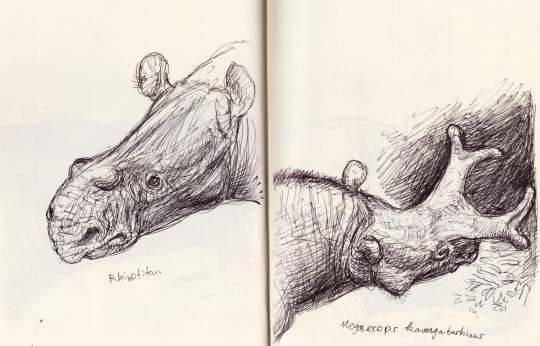


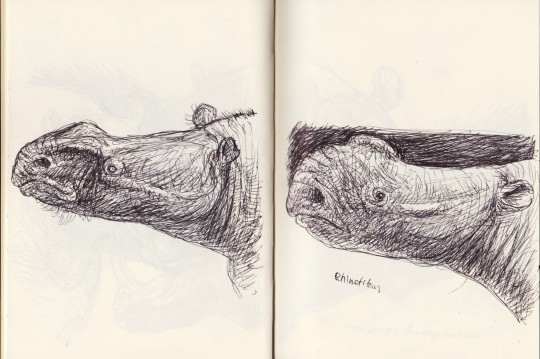

Some pages from one of my sketchbooks.
For some time I looked a little more at brontotheres, an often overlooked but beautiful and diverse group of mammals.
310 notes
·
View notes
Text
The NEW Ultrastenos and its Ironic History
So those that have been keeping up with my posts on mekosuchines might recall the name Ultrastenos, as I've talked about this genus back in August of last year. If you've read that post you might also remember how I highlight at multiple points that a lot of the info was tentative on the basis that Ultrastenos was highly incomplete and that close relatives awaited description.
You may also remember "Baru" huberi, a small mekosuchine that lived roughly around the same time, clearly distinct from Baru yet at that point still unnamed. Oh, how I wished for the former to get more material and for the latter to recieve a proper genus assignment.
My now outdated reconstructions for "Baru" huberi (the small one in the left image) and Ultrastenos (right image)

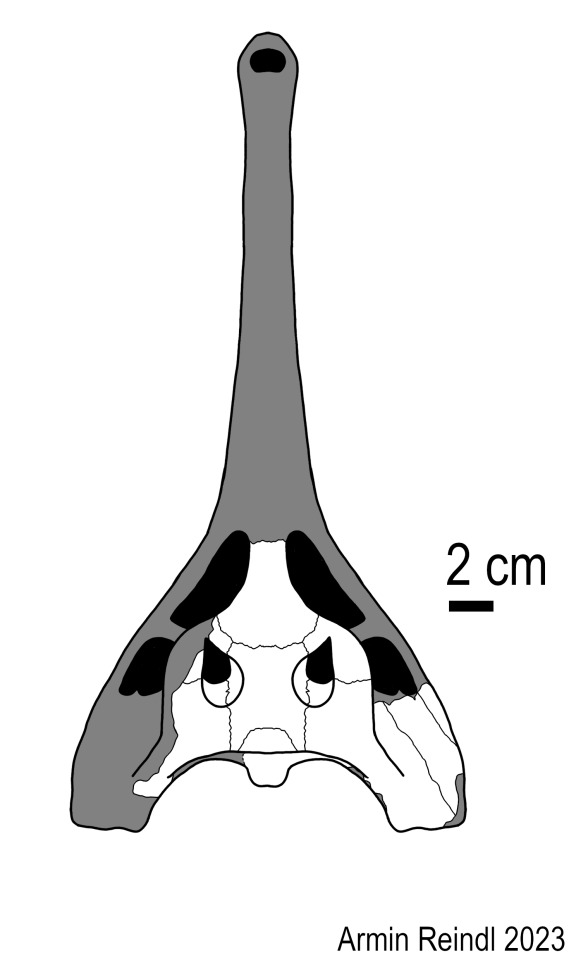
And then the monkey's paw curled.
As it turns out....they are the same damn animal.
Now, back when "Baru" huberi was described, Willis also named a bunch of other mekosuchines from the same locality (the White Hunter Site of the Riversleigh WHA) and described even more material that remained unnamed, including the White Hunter Cranial Form 1. Now, when Ultrastenos was named in 2016, the type material was from the Low Lion Site (also Riversleigh), but importantly, the skull tables identified as WHCF1 were also assigned to the genus (and were the basis for my reconstruction).
Well, re-examination has shown that the WHCF1 and the holotype of "Baru" huberi aren't just a single species.....THEY ARE A SINGLE INDIVIDUAL.
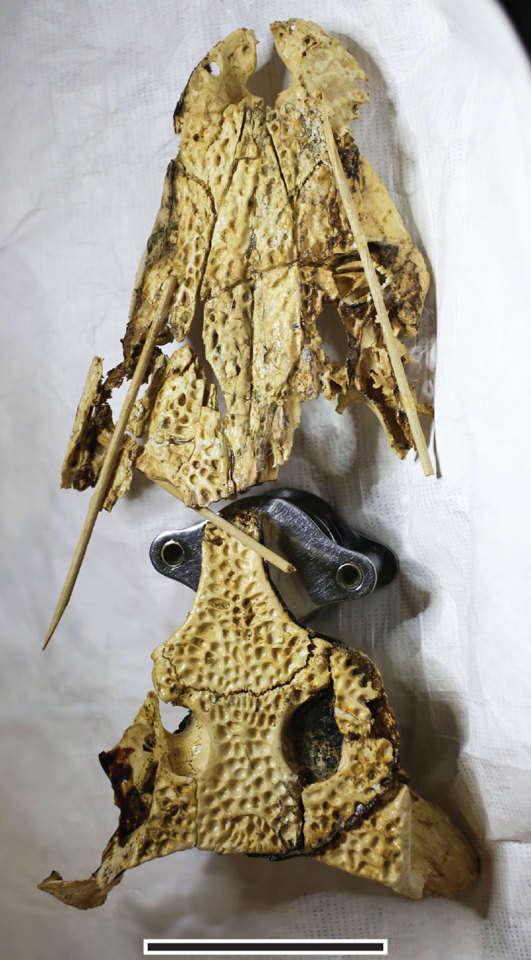
Given the fact that the assignment of the skull table to the Low Lion Ultrastenos material still holds up, this means that Ultrastenos willisi and "Baru" huberi are a single taxon. Which consequently requires some reshuffling of the names.
"Baru" huberi was named first, so the species name takes priority and continues being used. However, since it was never given a genus name, Ultrastenos does stay valid. Except now it's called Ultrastenos huberi, not Ultrastenos willisi.
A name that has aged like milk. Back in 2016 it was proposed that Ultrastenos had a very narrow snout (thus the name), so now that we know that the rostrum was flat and mesorostrine, the name really is just wrong.
So next up, lets examine what went wrong.
As I said before, Ultrastenos was fragmentary, so that certainly played a big part in it. But the team in charge of describing the animal still cited several lines of thinking to support their interpretation, most of which are now thoroughly debunked.
As an example, the lower jaw was rather shallow, however while this was initially taken as evidence for longirostry, the 2024 paper states that this only an argument against altirostry (a deep skull), not against a more generalized condition. The teeth were also initially used as evidence, citing their homodont condition (the teeth looked uniform), HOWEVER, the problem in that was that there were only a few teeth present, all of which notably do not bear any resemblance to the needle-like teeth seen in other long-snouted taxa. Another important clue initially taken to mean longirostry was the orientation of the quadrate area and the seemingly sudden constriction of the lower jaw. But the quadrate area was not found in articulation and would support a generalized skull form if simply rotated a little, while the constriction of the mandible appears to at least be partially exaggerated by preservation.
Of course, the fact that we now have proper material of the snout makes the interpretation of a generalized skull shape a lot more solid.
Image 1: The left and right halves of the mandible of Ultrastenos compared to that of Baru iylwenpeny (D), note how the right half is a lot more straight.
Image 2: The initial reconstruction of the quadrate area of Ultrastenos compared to one that is slightly rotated
Image 3: The revamped skull reconstruction by Yates and Stein

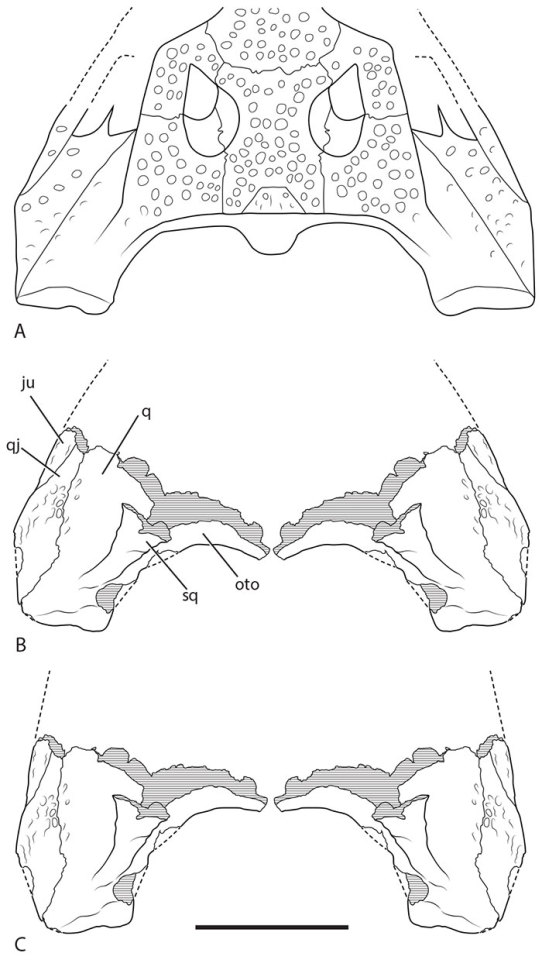
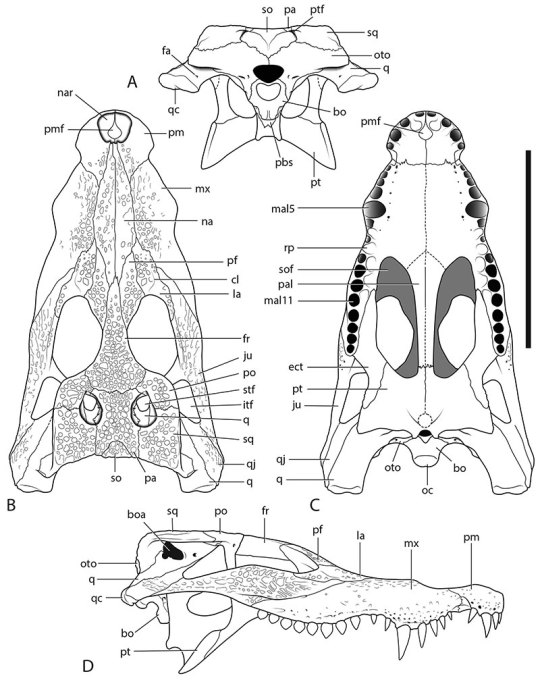
The size of the animal does stay relatively unaffected by these new discoveries. "Baru" huberi has been estimated at only around 1.5 meters in length and my own scaling of Ultrastenos got up to 2 meters, which seems to be in line with what is still assumed for this animal. So among aquatic mekosuchines, its still rather small.
There are however some interesting implications for mekosuchines at large. Now that we no longer have a longirostrine member of this family, one has to wonder, why is that?
Well, there might be several reasons.
It could be that the types of environments that were present in Cenozoic Australia simply didn't support such animals. Even in the type description, its been noted that the Riversleigh isn't exactly known for its fish remains, leading to the idea that Ultrastenos might have gone for other small vertebrates like frogs. Hell, the ecology of Baru might suggest that the reason that this genus was so robust might tie to the fact that the local bodies of water just weren't deep enough to allow the typical crocodilian grab-and-drown tactic.
Competition might have been another factor. In environments that may have been more suitable for such morphology, mekosuchines might have been beaten to the punch by other types of crocodilians. Harpacochampsa for example, tho originally thought to be a mekosuchine, is now more often regarded as either an unrelated crocodile or a gharial and its very possible that it filling the nische of a longirostrine simply meant that mekosuchines didn't have the opportunity to expand into that space. Same goes for Gunggamarandu in the Pliocene and Pleistocene and Freshwater Crocodiles from the Pleistocene onwards. (Tho it should be noted that both Harpacochampsa and Gunggamarandu are so fragmentary that their snout shape is technically unknown).
Images: Gunggamarandu (Eleanor Pease), Harpacochampsa (ArtbyJRC) and Freshies (Antoni Camozzato) might have been key factors in why mekosuchines never evolved slender snouts.
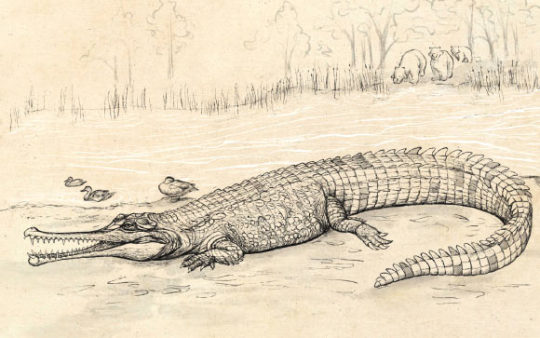
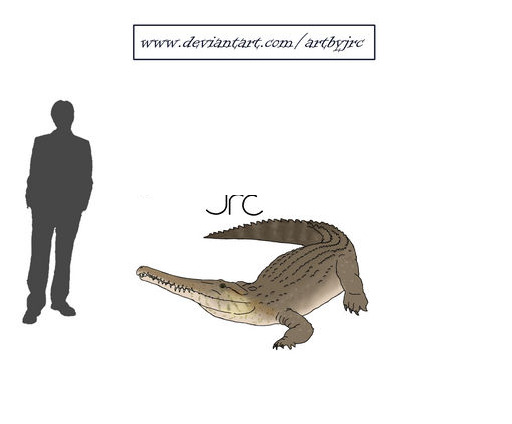
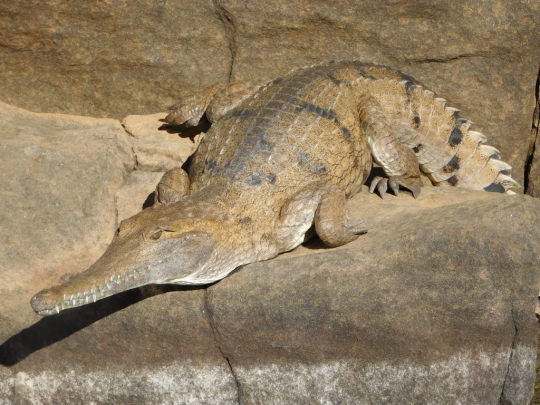
Finally, its also possible that something in the growth of mekosuchines simply prevents them from evolving longirostrine skulls, which Yates and Stein liken to alligatoroids (notably the closest alligatoroids got to traditional longirostry as seen in gharials is the Rio Apaporis Caiman, and even that one is closer to some extant crocodiles in its morphology).
Whatever the case, I for one mourn the loss of our long-snouted Ultrastenos. Tho as a note for any paleoartists, there is not a single illustration of this new interpretation since nobody ever drew "Baru" huberi either. Wink wink nudge nudge
Links:
https://en.wikipedia.org/wiki/Ultrasteno
Ultrastenos revised (palaeo-electronica.org)
#long post#harpacochampsa#ultrastenos#baru huberi#mekosuchinae#gunggamarandu#oligocene#riversleigh#paleontology#palaeoblr#croc#crocodile#crocodilia#prehistory#cenozoic
46 notes
·
View notes
Text
Praecarbo strigoniensis Kessler & Horváth, 2023 (new genus and species)

(Type tibiotarsus [fused shin and ankle bones] of Praecarbo strigoniensis, from Kessler and Horváth, 2023)
Meaning of name: Praecarbo = before [in Latin] Carbo [defunct genus name for the great cormorant, now in the genus Phalacrocorax]; strigoniensis = from Esztergom
Age: Oligocene (Rupelian–Chattian)
Where found: Mányi Formation, Komárom-Esztergom, Hungary
How much is known: The tip of a right tibiotarsus (fused shin and ankle bones).
Notes: Praecarbo appears to have been a cormorant, a group of waterbirds that primarily catch prey by swimming underwater, propelling themselves with their feet. If correctly identified, Praecarbo would be one of the oldest cormorants known.
Reference: Kessler, J. and I. Horváth. 2023. Praecarbo strigoniensis, a new genus and species of cormorants (Phalacrocoracinae) from the Late Oligocene of Hungary. Ornis Hungarica 31: 126–132. doi: 10.2478/orhu-2023-0008
35 notes
·
View notes
Text
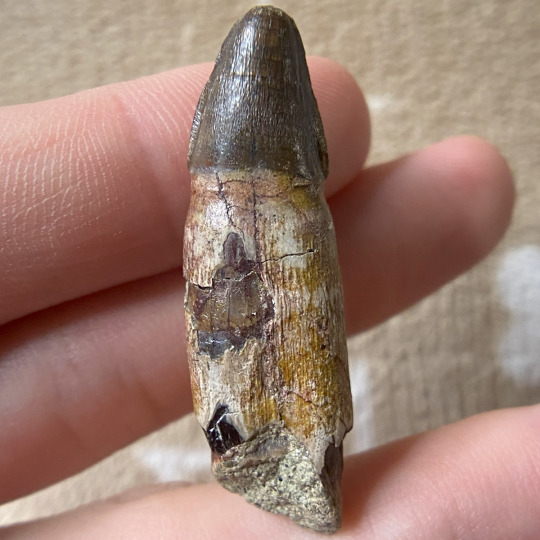
A fossilized rooted crocodilian tooth of an Alligator prenasalis from the Brule Formation in Custer County, South Dakota, United States. This Paleogene aged species of alligatorine is currently the oldest occurrence of the genus Alligator.
#crocodylomorpha#crocodilian#fossils#paleontology#palaeontology#paleo#palaeo#alligator#eusuchia#oligocene#cenozoic#science#prehistoric#paleoblr#アリゲーター#正鰐類#ワニ#化石#古生物学
8 notes
·
View notes
Text

Delicious, nutritious sunbaked Paraceratherium corpse! With Hyaenodon and Generic Vultures.
#vulture#palaeoblr#paleoblr#paleoart#palaeoart#paraceratherium#oligocene#paleontology#hyaenodon#yee art
135 notes
·
View notes